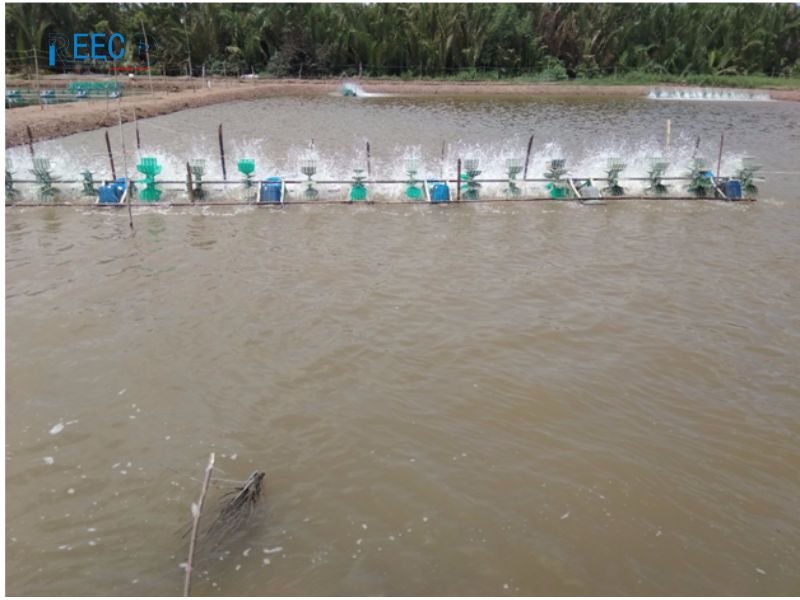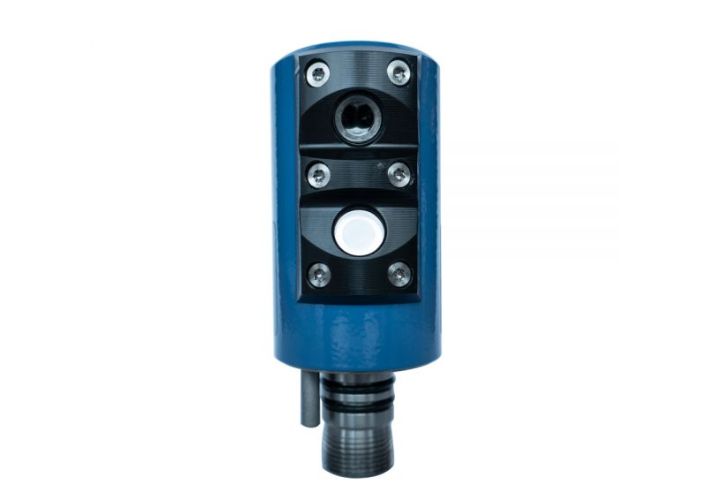Turbidity and clarity are two important parameters that can significantly impact the overall health of organisms in an aquaculture pond ecosystem, as well as the growth and development of aquatic species such as shrimp and fish. Evaluating these parameters is crucial for assessing water quality in aquaculture.
What is water turbidity?
Water turbidity, also known as water clarity, is the degree of loss of transparency in water, where water no longer maintains its inherent clarity due to the presence of suspended solids that are not visible to the naked eye. These suspended solids can be algae, dirt, minerals, proteins, oil, or even bacteria. Turbidity is an optical measurement indicating the presence of suspended solids.
Water clarity refers to the level of light penetration through water. Clear water is water through which objects beneath the water surface can be clearly seen. Water clarity depends on various factors, including turbidity, water depth, and water quality.
Turbidity and water clarity have an inverse relationship. The higher the turbidity, the lower the water clarity.
To ensure optimal growth for aquaculture, fishponds should have a depth of 20 to 30 cm, and shrimp ponds should have a depth of approximately 30 to 45 cm. Maintaining this depth provides favorable conditions for the healthy growth of aquatic species and yields high economic efficiency.
Factors Affecting Water Clarity and Turbidity
The following are some specific factors that can affect water clarity and turbidity:
- Algae: Algae are a type of phytoplankton that live in water. Algae can grow rapidly in warm, nutrient-rich water. Excessive algae growth can increase water turbidity, giving the water a green or blue color.
- Sediment: Dirt, clay, and other sediment particles can be washed into water from sources such as eroded soil, rivers, streams, and roads. These particles can increase water turbidity, giving the water a cloudy or brown color.
- Pollutants: Pollutants such as oil, chemicals, and heavy metals can increase water turbidity. These pollutants can be harmful to human and animal health.
- Human Activities: Human activities such as industrial and domestic wastewater discharge, pesticide use, and chemical fertilizer application can increase water turbidity.
- Other Factors: Water clarity and turbidity can also be affected by other factors such as water temperature, pH, and salinity.
Water clarity and turbidity are important indicators of water quality. Water clarity and turbidity need to be controlled at an acceptable level to ensure human and animal health, as well as to sustain the life of aquatic organisms.
The Impact of Turbidity and Clarity on Aquaculture
Total dissolved solids (TDS) are closely related to water turbidity caused by suspended solids in the water. These solids can block light from passing through the water, which can have the following effects:
If turbidity is high and clarity is low:
Light cannot penetrate deep underwater, which can negatively affect aquatic ecosystems, specifically:
Aquatic plants cannot photosynthesize, leading to a decrease in dissolved oxygen in the water, which affects the metabolism and respiration of organisms.
The rapid growth of phytoplankton can be inhibited, which can affect the stability of the living environment in the aquaculture pond.
The deposition of suspended solids in the body of organisms can affect their activity and flexibility. For example, dust and suspended particles can cover fish and reduce their ability to breathe, even causing injury.
Sedimentation of silt and mud also makes the water heavier, reduces the flexibility of organisms, and makes the environment darker and difficult to observe.
If turbidity is too low and clarity is too high:
Nutrient deficiency in the water can lead to the decline of phytoplankton and reduce the natural food source for aquatic organisms, causing ecological imbalance. Organisms living in this environment also become more sensitive. Very clean water often has a low temperature, which also affects the health of the organisms living in it.

2 Methods for Determining Water Clarity in Aquaculture
Water with high turbidity not only affects aesthetics but also creates a favorable environment for the growth of harmful bacteria. Therefore, we need to regularly check the turbidity level of the water source to be able to control and treat it promptly, ensuring the health of the whole family.
Visual Method – Using Secchi Disk
To perform this method, you need to use a Secchi disk – a simple tool to measure water turbidity. The Secchi disk is made of non-stainless copper alloy, capable of withstanding the effects of chemicals in the water environment.
The Secchi disk is a flat, circular disk with a rope 5-1m long, divided and marked clearly, with each section 20cm long. The process of measuring turbidity using a Secchi disk is as follows:
- Step 1: Assemble the Secchi disk, tie the rope to the round hook on the surface of the disk
- Step 2: Lower the Secchi disk into the water, hold the remaining end of the rope and slowly lower the disk until you can no longer see it, then stop.
- Step 3: Keep the status quo then observe and mark the point where the rope meets the water surface.
- Step 4: Then, lower the disc another 0.5m and slowly lift it up and read the depth value a second time.
- Step 5: Calculate the average depth value of the 2 measurements. The exact result is the index that shows the turbidity of the water.
>>> Learn more: Secchi Disk for Measuring Water Clarity

Turbidity Meter Method
The turbidity meter method is currently the most effective method for measuring water clarity in shrimp farms. A turbidity meter is a type of advanced water testing device, with easy-to-use operations, that helps to determine the clarity and turbidity of water not only in shrimp farms but also in any water source.
High accuracy and the unit of measurement NTU (Nephelometric Turbidity Units) are the outstanding features of these meters, and the measurement speed is also very fast, taking only a few seconds to display the measurement result in a specific number.
=> Learn more: Turb 750 T Benchtop Turbidimeter

Turbidity Sensor
A turbidity sensor, also known as an optical turbidity sensor, is based on optical principles and is not affected by ambient light when underwater. It can measure depths of up to 6000 meters.
Reecotech supplies turbidity sensors from many famous brands in the world such as:
Turbidity sensor and total suspended solids (TSS) calculation – YSI: The EXO turbidity sensor is an intelligent digital sensor with a titanium weld head and moisture-resistant connectors. Calibration is completed in 15 minutes using the EXO’s smart sensor and intuitive KOR interface software.
- Measurement range: 0 to 4000 FNU, NTU
- Response time: T63 < 2 seconds
- Accuracy: 0.3 FNU or ±2% of measured value from 0 to 999 FNU

The 4296 Turbidity Sensor from ANDERAA measures temperature and turbidity parameters.
- Smart sensor for easy integration with SeaGuard and SmartGuard
- Direct readout of engineering data, multipoint factory calibrated
- Enter site specific reference data to receive absolute values in mg/l
- Low power consumption
- Rugged and robust with low maintenance needs
- Output format AiCaP CANbus, RS-232
- Available in 3 depth ranges, 300, 3000 and 6000 meters
Common Methods for Reducing Turbidity in Water Today
Testing and measuring water turbidity is crucial for finding effective water treatment solutions. Various methods can be used to make our water sources cleaner and safer.
Using Alum to Clean Water
The chemical formula for alum is KAl(SO4)2.12H2O. This method has been used for a long time because it is simple, fast, and cost-effective. With just 1 gram of alum, you can treat 20 liters of water.
How to use: Simply add alum to the water to be treated. After a certain time, the impurities will settle to the bottom and the water will become clearer.
Using Chlorine Chemicals
The method many people choose to effectively disinfect water is to use salt. Salt is usually in the form of crystals, is white and opaque, and has the ability to kill pathogens in water.
Using Salt to Reduce Turbidity in Water
Using salt to disinfect water is very simple. You just need to add a certain amount of salt directly to the turbid water, then stir or let it dissolve naturally. The water will gradually become clear and effectively reduce pollution.

These are the two most popular methods for measuring turbidity and clarity today. If you want to buy or need a water quality monitoring solution for aquaculture, please contact Reecotech with the following information:
REECO Science and Technology Company Limited
Email: info@reecotech.com.vn
Hotline: +84 938 696 131 (Sales Department) / +84 901 880 386 (Technical Service Department)
Website: reecotech.com.vn
Fanpage: Reeco Tech Co., Ltd



